Operation 200 Part 4: Lights, power and ice cream

Now that we have been travelling for 10 weeks we can start reporting on how everything is working out.
As Operation 200 takes shape, we round out the final stages of turning our stock 200 Series LandCruiser into the ultimate touring and towing vehicle. Most stock tow vehicles will exceed their legal carrying capacity once it’s loaded with equipment and the ball weight of a van. So, our first step was to increase our GVM with a Tough Dog suspension upgrade to add to our safe and legal carrying capacity.
With an extra 500kg of capacity, we were able to add MSA drawers and a fridge slide and barrier, so the next option is a suitable fridge. We already had a fridge in the caravan that could handle day-to-day requirements, but we lacked a decent freezer for long-term food storage. Because we planned remote travel and camping, having a descent supply of food is important. As it turned out, it was a smart move. When we reached the Kimberley, many roads were closed because of unseasonal rain, and we ended up camped for nearly a week waiting for the water to drop. With a freezer full of food we had no worries about relying on my very unreliable fish catching prowess. Bear Grylls I am not.
Cool change
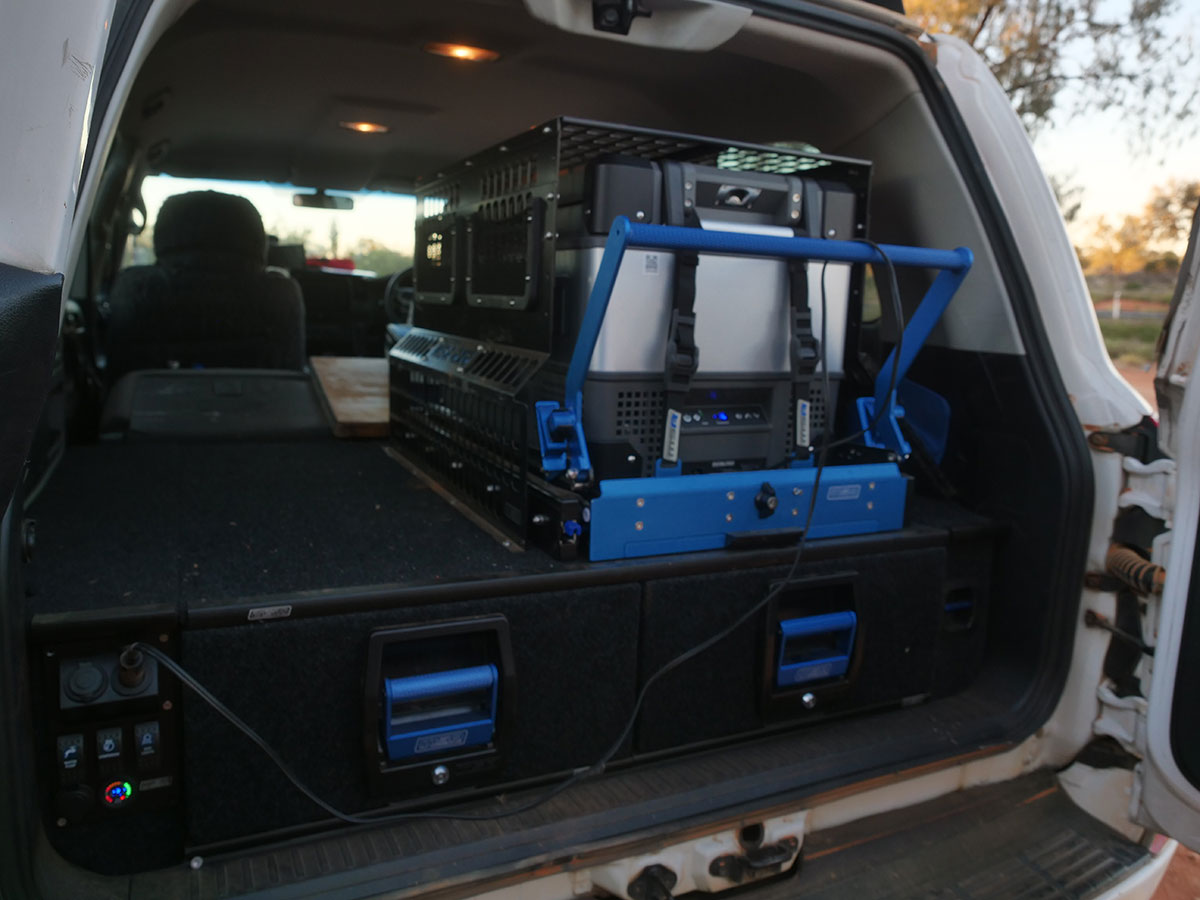
We chose the myCOOLMAN 60L All-Rounder which gives the options of either a fridge or freezer. We added a lithium power pack as a backup for when the vehicle battery wasn’t enough or we wanted to move the fridge closer to the campfire. Other myCOOLMAN versions have dual zone operation and range in size from 30L to 105L. For us the All-Rounder was just the right size for ample storage and ease of use on our MSA fridge slide. Operation is from 12V or 24V batteries as well as 240V mains power, so it suited our car mounted 100Ah Redarc lithium battery already in the 200. It seems the size of modern fridges is rated by can capacity, so if you want to use the All-Rounder as a fridge, then it will hold 96 cans or four slabs.

The 60L myCOOLMAN is a hefty 25.6kg so once loaded it’s a two-person task to move it around. Happily, access on the MSA fridge slide is an easy process and you have the option of opening the lid from the side or the end. A large top basket holds about half the capacity, and it lifts out to access the bottom layer. Sections move out of the way if you want to store larger bottles upright.
A digital display shows current freezer temperature and there’s a set of easy to understand controls to set temperature and battery cut out range. There’s an internal light, two bottle openers and even a USB outlet to charge devices.
The compressor is German designed and is very quiet when running. We have been running the fridge for nearly three months at -18deg without a hitch. A Bluetooth app keeps us up to speed with operation and lets us know if the temperature rises or the power supply drops. Power consumption varies with the ambient temperature. The first part of our travels was in the milder parts of Central Australia when the freezer would run for up to 30 hours on the 100Ah battery without running the car. As things have warmed up — sometimes on the low 30s — run time is around 24 hours so we have been replenishing the battery from the 120W BMPRO solar panel if we are parked for more than a day.
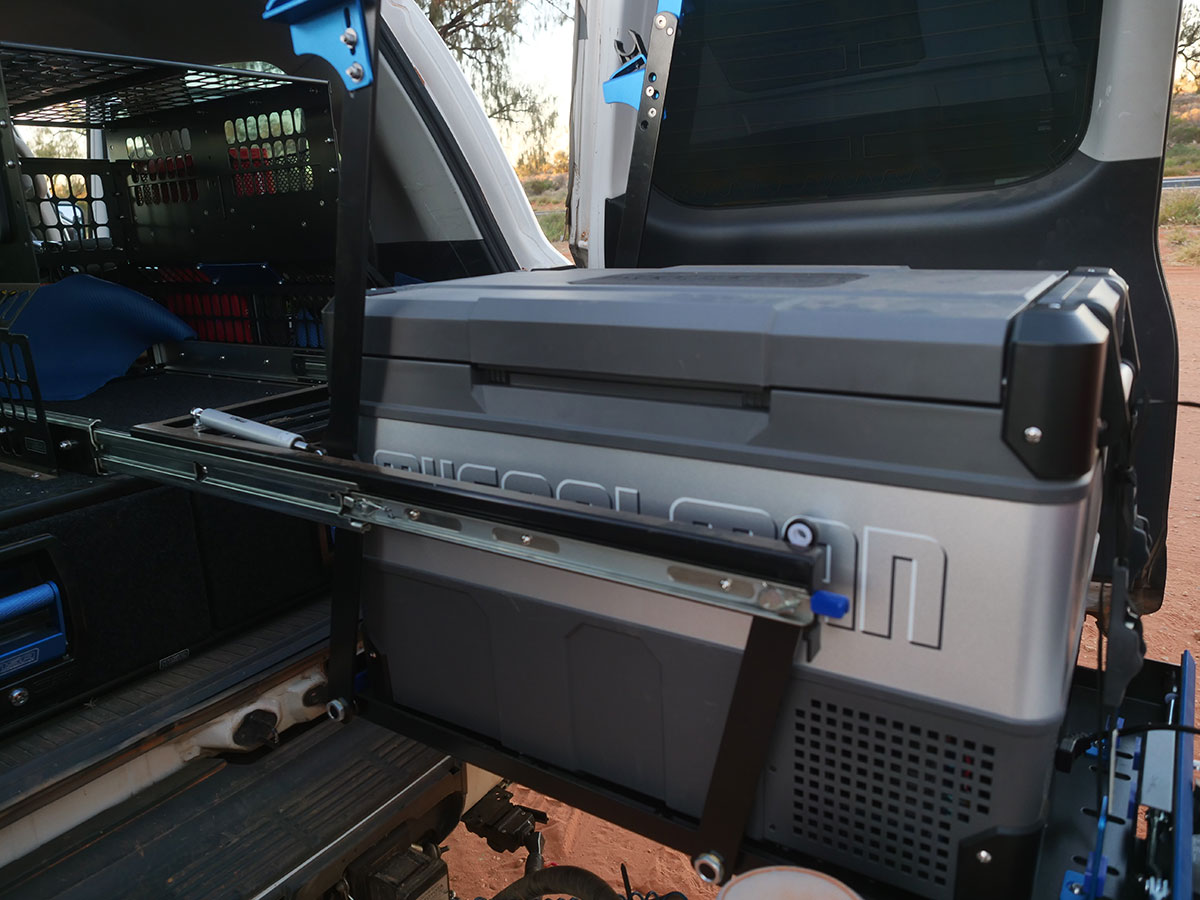
A couple of times we took our eyes off power usage when were using the vehicle’s 240V inverter for other applications. Plugging in the power pack kept us running overnight with no drop in freezer temperature. The pack is magnetic and slots onto the end of the fridge where it stays securely behind the tie down strap, where is nice and handy, when we are travelling. We charge it to keep peak power from the vehicle inverter when travelling and a set of LED lights show battery capacity.
We are very happy with the All-Rounder. It holds enough frozen food to keep us going for weeks and it has been very reliable over a big range of temperatures. It stood up to rough travel including many kilometres of corrugations on the Gary Junction Highway and through Kalbarri National Park, as well as down rough and rocky tracks without the van.
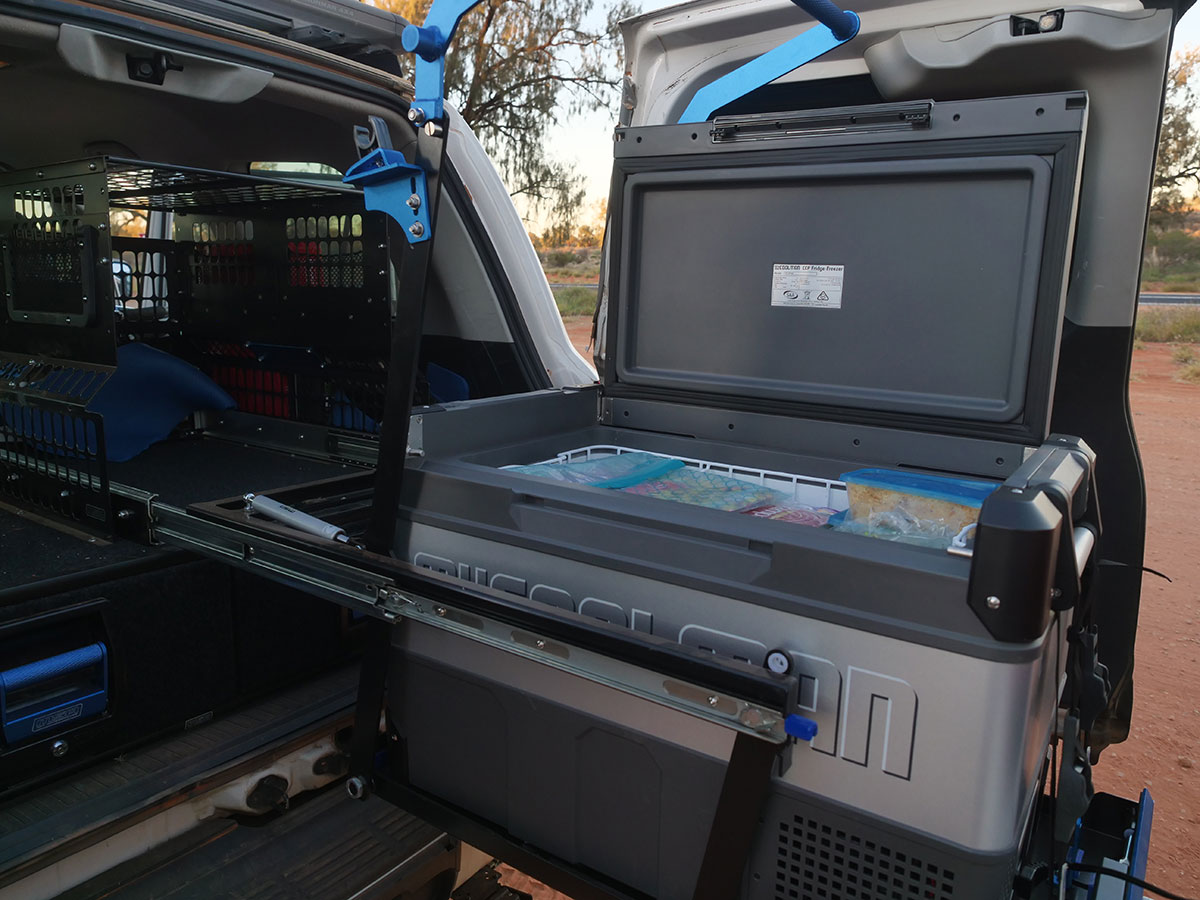
The 60L All-Rounder is $1449 and the power pack is $449. Available from most camping stores and online at myCOOLMAN.
Escape the dark side
Narva’s latest EX2 driving lights are a reasonably priced and very effective way to light up the path ahead.
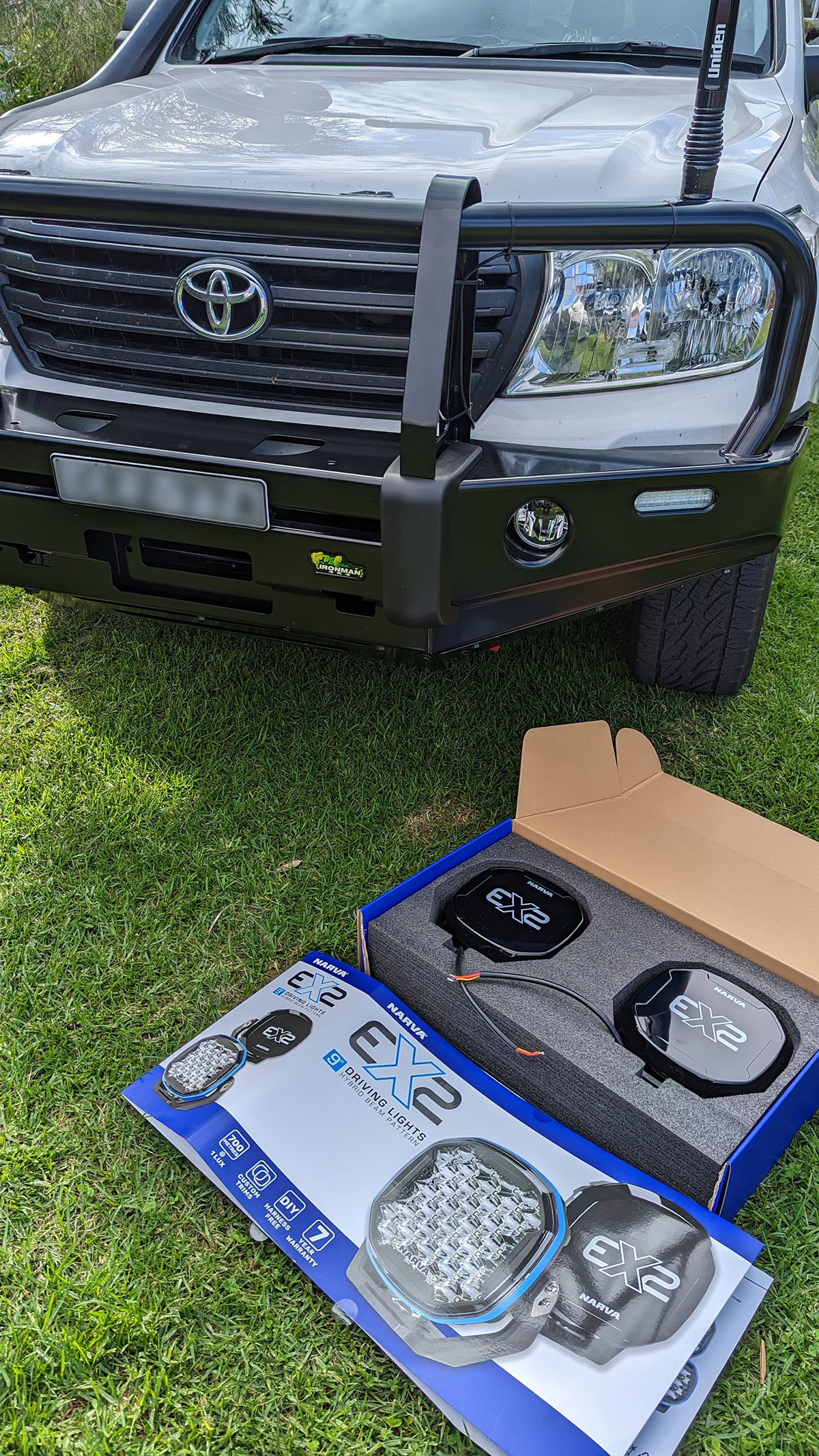
I will happily admit my night vision isn't great, and because I drive a lot after sunset, I have always fitted extra lights to my vehicles. I’m old enough to see the progression through the various improvements over time. Starting with a set of 5in spotties with halogen 50W globes on an early LandCruiser, some SEV Marchals and Cibie Super Oscars on a replica Datsun 1600 rally car, I then discovered some cheap imported 9in LEDs for a collection of 100 Series LandCruisers. The LED versions were a breakthrough and, if anything, too bright in some circumstances when flashed against large reflective road signs.
Fitting driving lights to our 200 was never in doubt, and once we had the Ironman bulbar installed, the lights were a priority. Many caravanners, even those covering many kilometres of outback travel, elect to exclude bullbars and lights because they travel only during the day. I see an excellent argument for that choice. Both reduce aerodynamic efficiency, and a 200 doesn't need more wind resistance. It's bulky enough already. So, like nearly every accessory, a bullbar and lights are a compromise. It's horses for courses and lighting up the night was the course we chose.
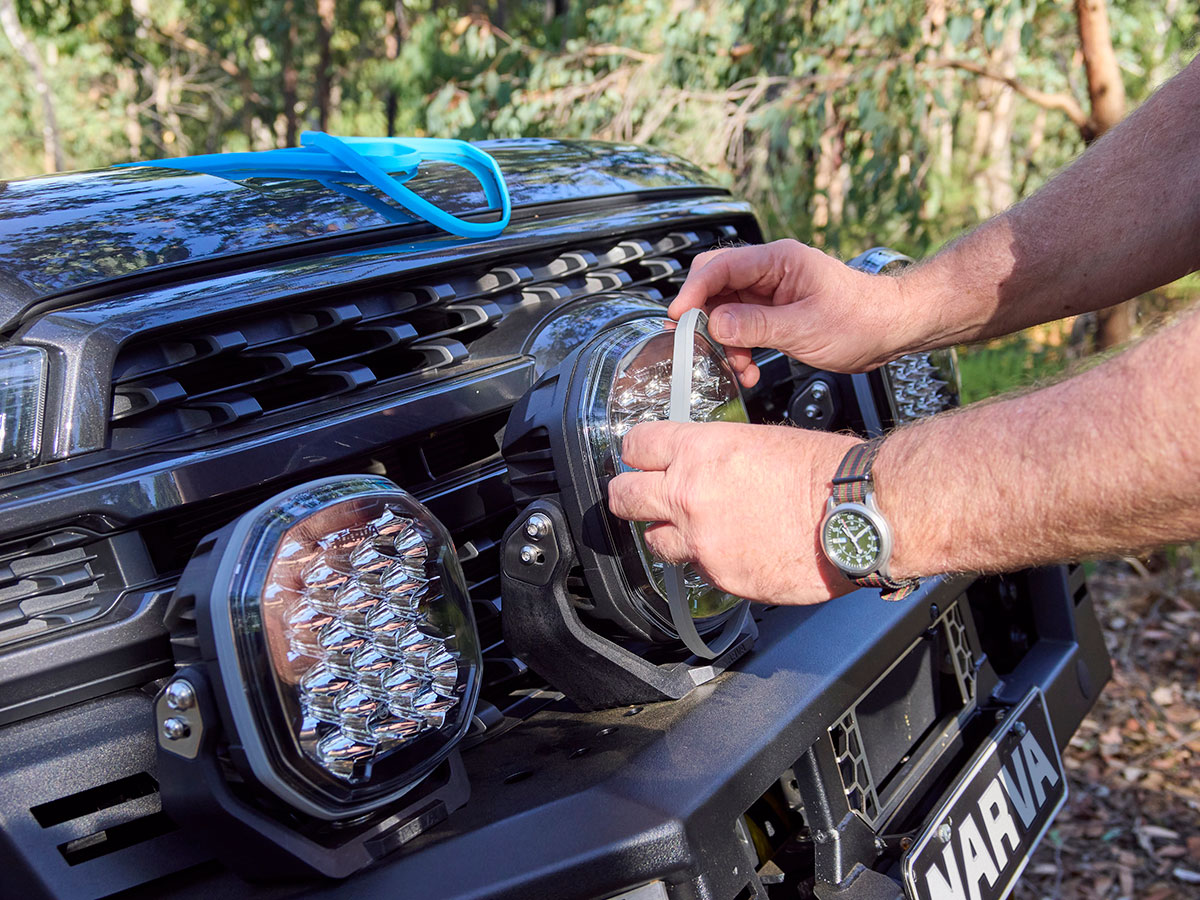
LED lights are superior to almost any light that came before in every way. They run cooler, are more energy efficient, less fragile and last longer. They are also self-contained, needing no ballasts and have no warm-up time. Good ones also have effective water and dust proofing.
The choice of lights on offer is ever expanding but with claims about performance ranging from unbelievable to mystifying. When a company claims their light has 1lux at 1000m, that means the equivalent of the strength of one standard candle lighting an object one metre away. Are you any wiser?
Experience had shown me that I wanted lights that would clearly show the way for about 500m and with good clarity to the sides. I didn't need to know what was 5km ahead until I got there because it was irrelevant and too confusing for my limited mental capacity. Clear vision to the sides is essential because that is where animals lurk, and we need to be forewarned they are about to cross in front.
Narva is an Australian company that has been making lights and electrical components since 1957. Its latest EX2 range was unveiled as powerful lights with a funky customisable look earlier this year. We chose the 9in version, and I was happy to see they include patented switching, which makes for easy installation. The lights come with a well-made wiring loom that does away with in-cabin switching to meet the latest ADR compliance.

The lights were designed, engineered, tested and assembled in Australia and have a remarkable seven-year, no-fault warranty. I understand if they fail or you damage them, Narva will replace them. Now, that's a proper warranty.
Each light has 40 x 5W Cree LED globes for a total of 200W. Output is 19,400 measured lumens which translates to one lux at 700m. Initially, that doesn't sound that remarkable, but let’s hold that thought. The body of the light is cast aluminium with a polycarbonate lens and a composite mounting bracket designed to absorb vibration.
The lights came reassembled and with the wiring loom ready to go. Fitting was probably the easiest accessory task I have undertaken. Mount the lights on the bar, wire in positive and negative leads to the battery and splice in a wire to the high beam feed; tighten the stainless-steel Allen screws, and that's it, apart from checking the alignment with a quick night drive. I liked the coloured trim options that clip onto the light and the robust removable covers that clip securely in place. There are eight trims to match your custom vibe.
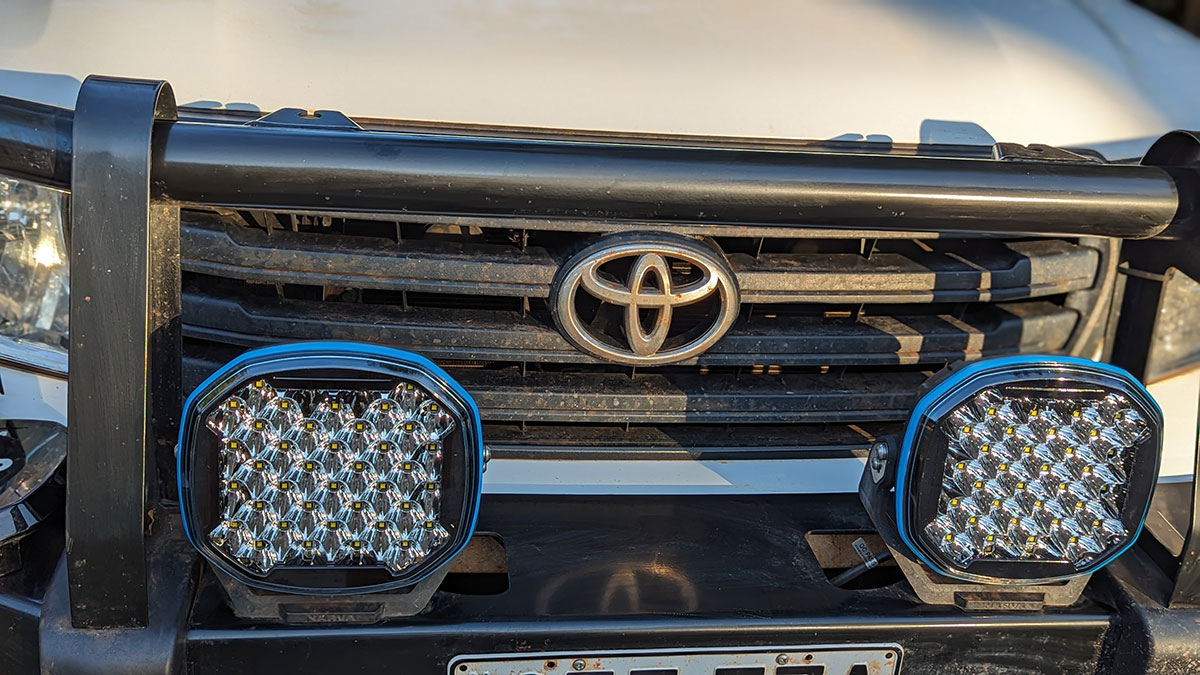
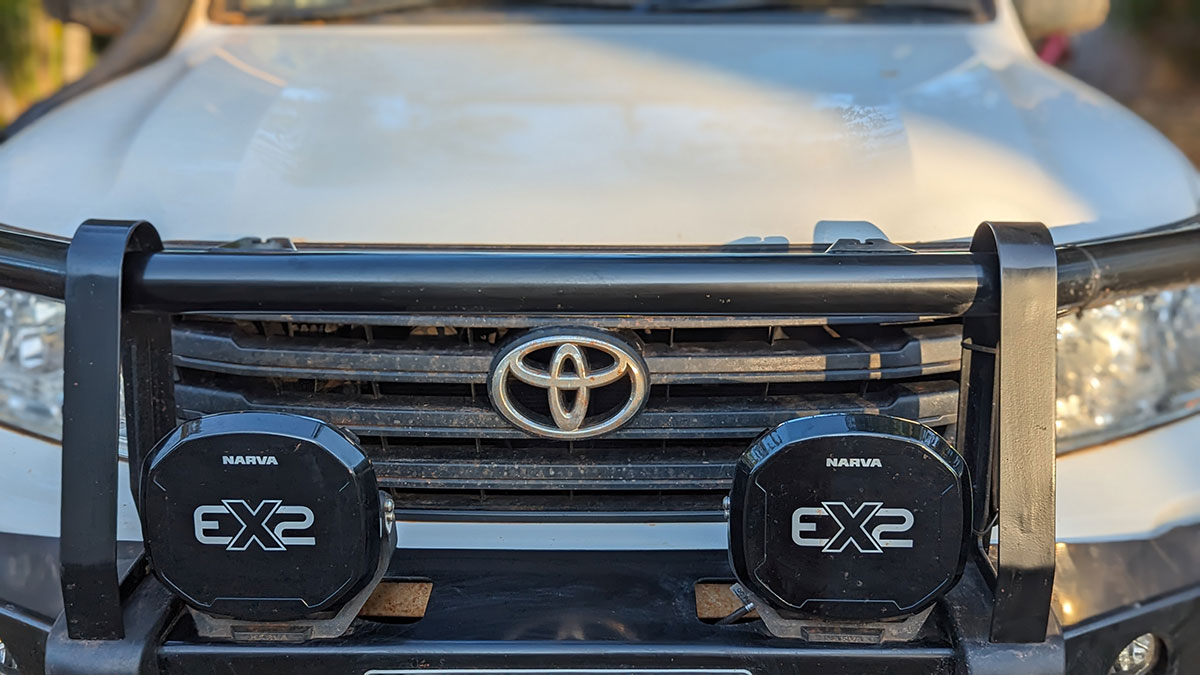
As mentioned previously, compared to some lights in the market, the EX2's specified one lux at 700m seemed a bit light on, if you will excuse the pun. In practical terms, it was perfectly suitable for a sensibly driven 4WD. The beam is bright to over 500m ahead and, because of the hybrid wide and narrow beams, projects well to the sides. The 5200k colour temperature is the same as daylight, so you won't experience eye strain when driving long distances.
The wide light path has no dark patches, so it illuminates the way for on and off-road conditions. There was no vibration over normal roads, and while the lights moved around with the bullbar on bad corrugations, the effect wasn't distracting.
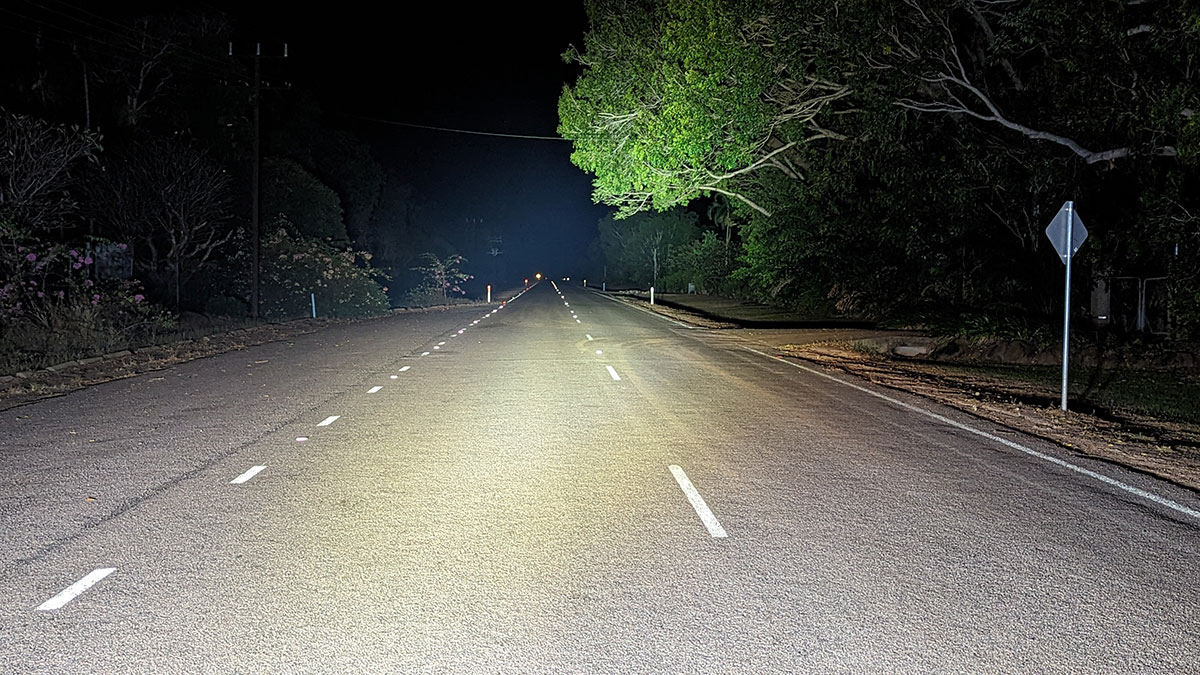
Narva EX2 lights come in 4in, 6in, 7in and 9in sizes. The 9in version is $699 a pair at most parts retailers. I'm happy with the quality build and how they light up the road ahead. Add in the very generous warranty, and that makes them remarkable value.
Photons to neutrons
A vehicle set up for off-grid camping has to be self-sufficient, so an independent charging system for batteries is essential. Here we check how Projecta's folding solar panel has worked out.
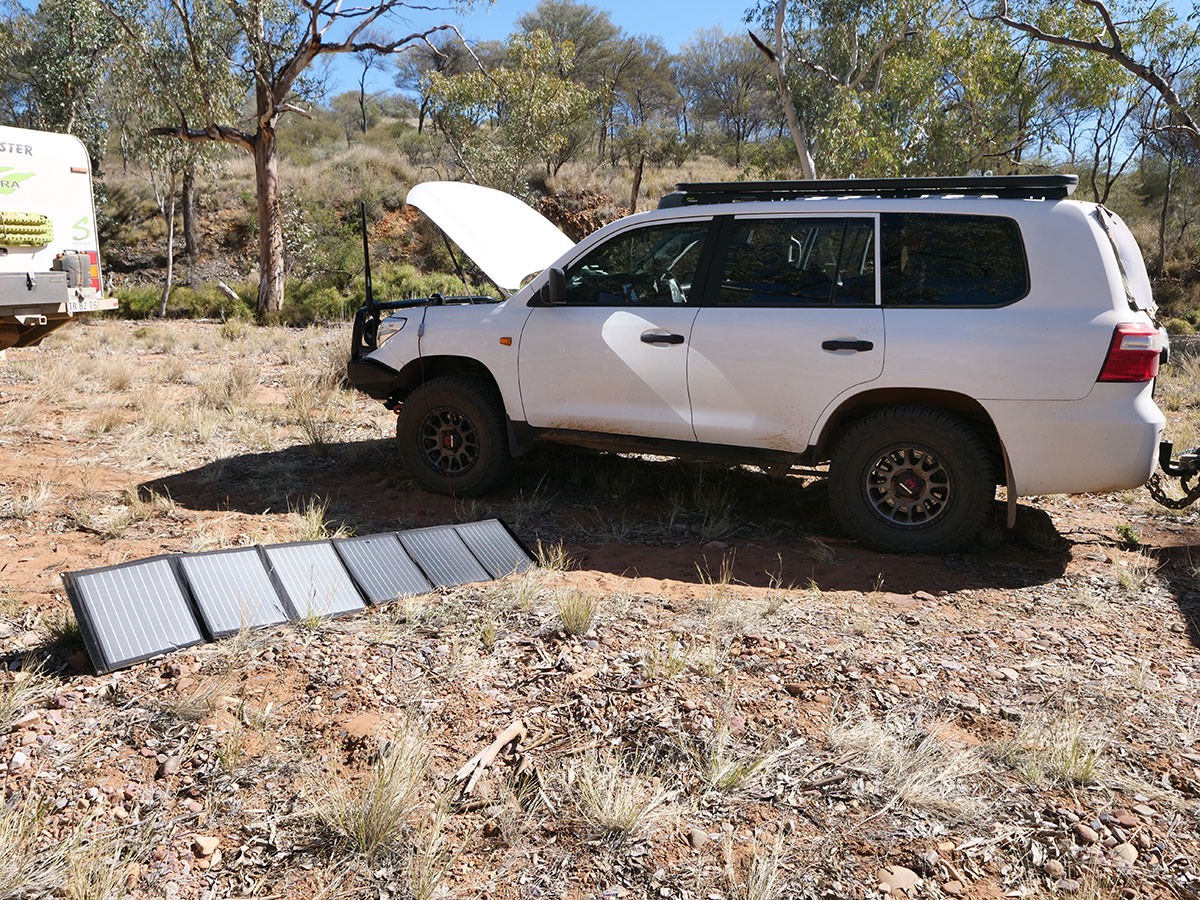
Our 60L freezer in the 200, powered by a 100Ah lithium battery, has significantly affected how long we can stay off-grid. Before we left home, we stocked it with frozen flathead fillets, a few kilos of my favourite local sausages, plenty of frozen vegetables and a few ready-to-cook meals. The generous 60L capacity means we can stock up further with more delicacies as we travel. In freezer mode, it stays at -18c for about a day without additional charge from the car’s alternator as we drive. So, we needed a solution to keep the battery topped up if we stayed for more than two nights in one place.
Our solution came from Projecta with a 120W folding solar panel. We all know about rigid solar panels because most caravans have some on the roof. But soft folding panels are relatively new, offering a versatile, efficient, easily-stored solution to charge your batteries.
Projecta is an Australian company making electronic products for the RV industry. They have been developing and engineering their range of innovative and high-end equipment in Melbourne since 1987 and are best known for their selection of battery chargers and monitors.
Their SPM120K solar blanket has six monocrystalline panels set in a heavy-duty canvas backing that produces up to 120W of charge. Monocrystalline solar panels offer the highest efficiency rates and power output for a solar panel. Each of their solar cells is made from a single silicon crystal rather than the cheaper polycrystalline panels that are made from silicon shards or amorphous panels formed from non-crystalline silicon over glass or plastic.
So, monocrystalline panels cost more to make but are more powerful and robust. In simple terms, the silicon semiconductor converts light into electricity by turning photons into electrons. Higher quality semiconductors are more efficient and take less space for the same output.
The 120W Projecta panel opens to 500mm x 1200mm and folds to 500 x 360 x 100mm. Weight is 7kg. Velcro strips keep it securely folded, and a built-in pocket holds all the accessories. Included are a collapsible fibreglass wand that slots into pockets sewn along the top of the canvas and three metal legs to angle the panel to its optimum position to the sun. A 5m fused lead with Anderson plugs lets you place the blanket away from the car in the sunniest spot. Meanwhile, a pulse width modulated (PMW) regulator has four-stage charging to prevent damage to a selection of AGM, gel, lead acid and calcium batteries. Discharge protection prevents current from flowing back to the panel at night.
Because it folds into a compact space, the Projecta panel has proven very handy over the past 10 weeks or so on the road. We found a safe spot for it in the back of the car to the side of the fridge slide, where we can quickly find it among all our travelling kit.
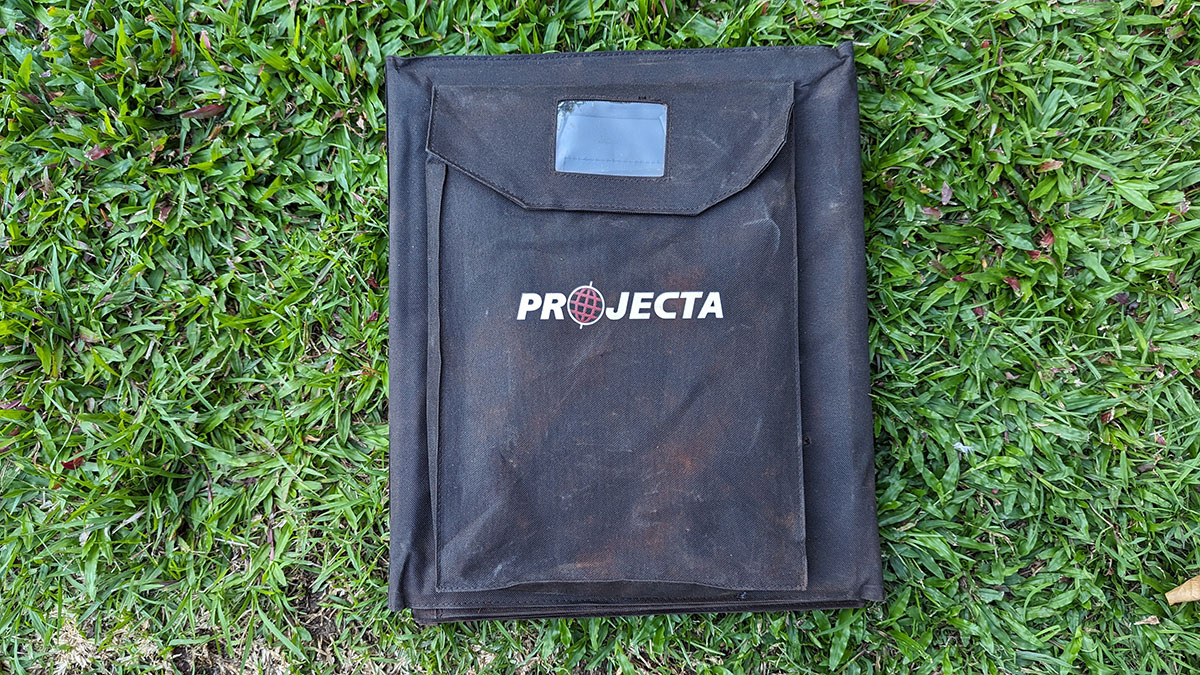
We mainly use it to top up the vehicle’s lithium battery through its solar-ready charger. We just plug it straight in without the supplied regulator. As mentioned in the writeup of our freezer, the panel will keep the All-Rounder fridge at -18C indefinitely under full sun. In cloudy weather, we sometimes need to run the 200's engine on idle for half an hour to bring the battery up to spec.
We also use the panel to augment the caravan’s solar system. Again, we plug it straight into the solar inlet and let the caravan’s solar charger sort out the charge. We often see seven amps of extra charge from the blanket on the caravan's monitor. It's particularly useful when the caravan's panels are covered in the shade because we can position the blanket where it's at its best without moving the van.
An unexpected benefit of the panel showed one morning when the 200's start batteries were dead. I had left the car plugged into the van, and it was powering the three-way fridge for a day and a night. Silly, I know, but luckily we weren't planning to move from camp and plugged the solar panel and regulator into the batteries, and we were charged enough to start the car in about three hours. This backup charging power could prove invaluable.
I like the quality construction, which gives confidence it will last for years. The built-in stand is a nifty, useful feature, and I also like how the whole system packs down into a compact unit that doesn’t take up much space. It has a recommended retail price of $1048.
The Projecta SPM120K solar blanket has been a valuable addition to our travels over the past three months. The panel tops up batteries quickly when needed and easily deploys into the most efficient place to catch the sun. We have been impressed by how well it has kept the freezer running when parked, but I especially liked how it saved our bacon when we needed it to charge the start battery. The Projecta solar blanket is a worthwhile part of anyone’s touring kit where you know it will do the job when you need it most.
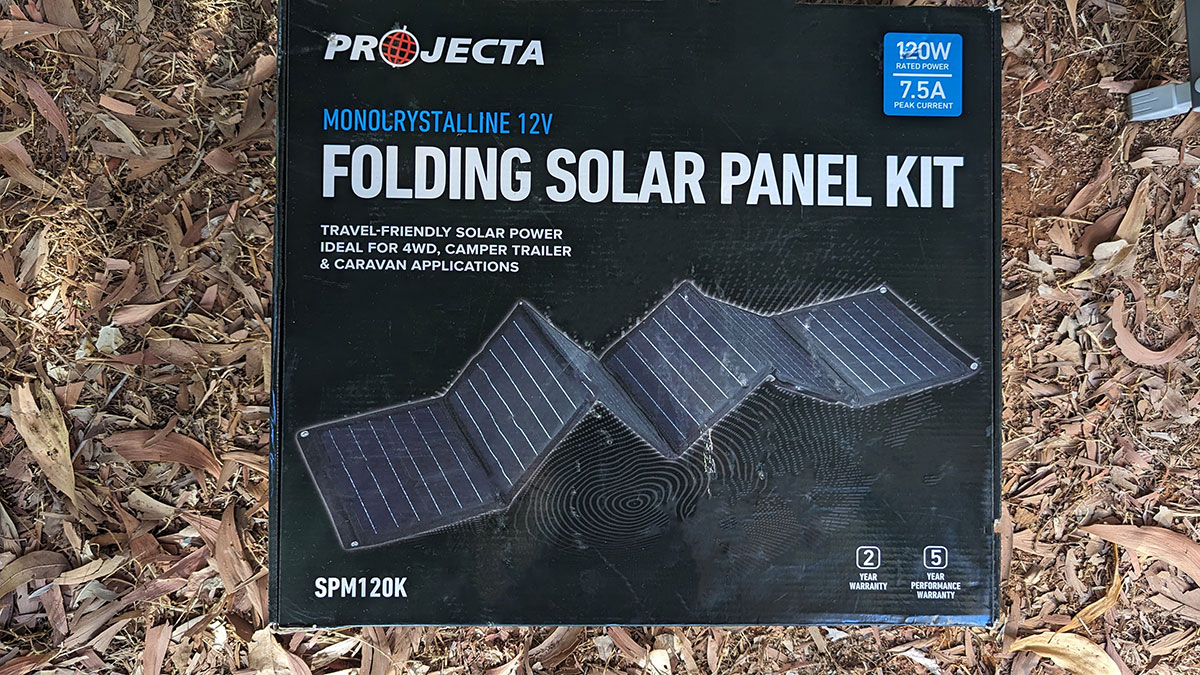
THE NEXT STEP
Are you ready to experience the freedom of the open road? Don't wait - Find your dream getaway now!
RELATED ARTICLES:
Operation 200 Part 1: Legal and loud







